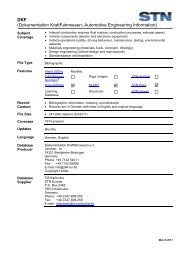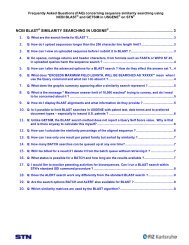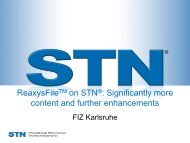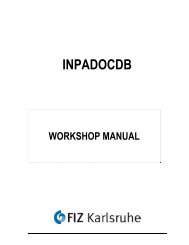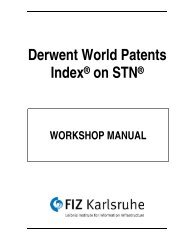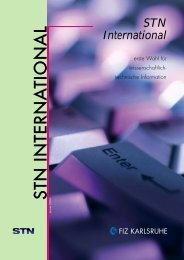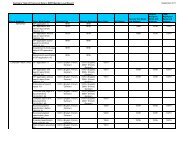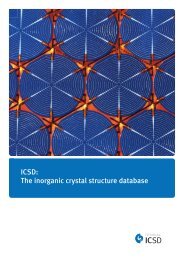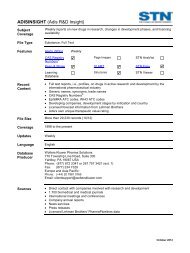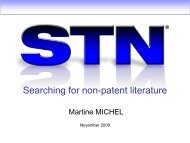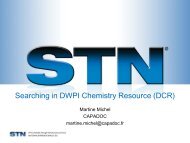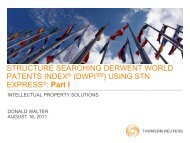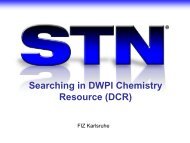note - FIZ Karlsruhe
note - FIZ Karlsruhe
note - FIZ Karlsruhe
You also want an ePaper? Increase the reach of your titles
YUMPU automatically turns print PDFs into web optimized ePapers that Google loves.
Nucleic acids<br />
Appendices<br />
Nucleotide sequence Feature tables have an extensive list of possible feature keys. Each feature is<br />
tagged and can be qualified with one or more “qualifiers”. Each feature can be further described<br />
by a “<strong>note</strong>”. Notes are used when there is no appropriate qualifier for a feature, or when<br />
information given in the qualifier requires further explanation.<br />
An example of a nucleotide sequence feature table<br />
FEATURE TABLE:<br />
Key |Location |Qualifier |<br />
===============+==========+==================+=============================<br />
CDS |1..2073 |*tag= a /partial |<br />
| |product |"TyrA"<br />
| |<strong>note</strong> |"Contains one intron, no stop<br />
| | |codon given"<br />
transit_peptide|1..174 |*tag= b |<br />
exon |1..1088 |*tag= c |<br />
| |number |1<br />
intron |1089..1181|*tag= d |<br />
| |number |1<br />
exon |1182..2073|*tag= e |<br />
| |number |2<br />
Feature keys for nucleotide sequences<br />
Feature Definition<br />
allele a related individual or strain contains stable, alternative forms of the same gene which differs<br />
from the presented sequence at this location (and perhaps others)<br />
attenuator 1) regions of DNA at which regulation of termination of transcription occurs, which controls the<br />
expression of some bacterial operons;<br />
2) sequence segment located between the promoter and the first structural gene that causes<br />
partial termination of transcription<br />
CAAT_signal CAAT box; part of a conserved sequence located about 75 bp upstream of the start point of<br />
eukaryotic transcription units which may be involved in RNA polymerase binding; consensus =<br />
GG(C or T)CAATCT[1,2]<br />
CDS coding sequence; sequence of nucleotides that corresponds with the sequence of amino acids in<br />
a polypeptide (location includes stop codon)<br />
cellular cellular genomic sequences that have recombined with a foreign sequence (from the organism<br />
specified in /ORGANISM qualifier) conflict independent determinations of the “same” sequence<br />
differ at this site or region<br />
D_loop displacement loop; a region within mitochondrial DNA in which a short length of RNA is paired<br />
with one strand of DNA, displacing the original partner DNA strand in this region; also used to<br />
describe the displacement of a region of one strand of duplex DNA by a single invader in the<br />
reaction catalyzed by RecA polypeptide<br />
enhancer a cis-acting sequence that increases the utilization of (some) eukaryotic promoters, and can<br />
function in either orientation in any location (upstream or downstream) relative to the promoter<br />
exon region of genome that codes for portion of spliced mRNA; may contain 5’UTR, all CDSs, and<br />
3’UTR<br />
GC_signal GC box; a conserved GC-rich region located upstream of the start point of eukaryotic<br />
transcription units which may occur in multiple copies or in either orientation;<br />
consensus=GGGCGG<br />
iDNA intervening DNA; DNA which is eliminated through any of several kinds of recombination<br />
insertion_seq insertion sequence; IS; a small transposon that carries only the genes needed for its own<br />
transposition<br />
intron a segment of DNA that is transcribed, but removed from within the transcript by splicing together<br />
the sequences (exons) on either side of it<br />
GENESEQ on STN (DGENE) Workshop Manual | Page 129



